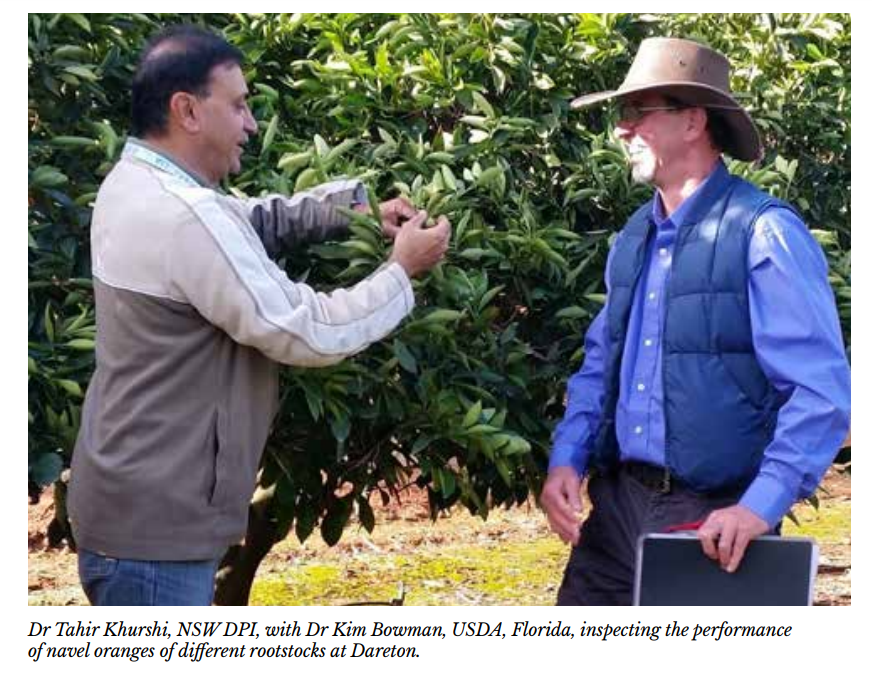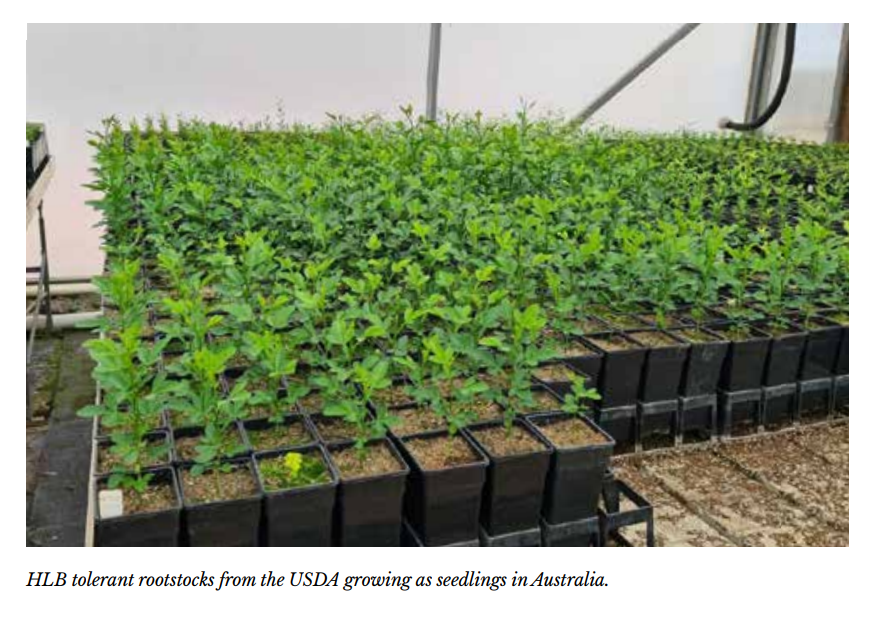27 October 2021
Establishing HLB tolerant rootstock trials for the Australian citrus industry
Rootstocks affect yield, fruit size and quality.
They also vary in their adaptability to different soil types, tolerance of adverse soil conditions, pests and diseases as well as their suitability for use on replant sites.
Different rootstocks are appropriate for different varieties and planting systems.
The most appropriate rootstock will depend on site characteristics, intended planting system, the likelihood of specific pest, disease or salinity problems, the variety to be grown, planned market outlets and marketing strategies for the fruit.
Certain rootstocks have resistance or tolerance to phytophthora, citrus tristeza virus (CTV), nematodes and other diseases.
It is now well established that Huanglongbing (HLB) (Candidatus liberibacter asiaticus) or citrus greening disease is devastating, having damaged citrus crops around the world.
HLB is a bacterial disease that is transmitted by a vector, the Asian citrus psyllid (ACP), which spreads through the tree canopy, causing tree decline and then death. Similar to the citrus leaf miner, the ACP requires a new flush of leaves for reproduction.
However, unlike the citrus leaf miner, adult ACP can survive on hardened leaves and if not controlled, will move to new flush as it becomes available.
Therefore, suppressing adult ACP during winter (i.e. before the new spring flush) will be helpful.
HLB is not present in Australia, however, if infected plants, budwood, cuttings or rootstock were imported, this could change.
Therefore, there is an urgent need for the Australian citrus industry to safeguard itself against HLB. HLB is present in neighbouring countries to our north and the Torres Strait Islands; both could provide a potential pathway for its spread into Australia.
I am leading a Horticulture Innovationfunded project ‘Evaluation of new rootstocks for the Australian Citrus Industry’ at the NSW DPI Dareton Agricultural Research and Advisory Station.
One of the key components of this project is to import HLB tolerant rootstocks and to test them with different scion varieties in different citrus growing regions of Australia.
Currently there are no rootstocks available in Australia that are HLB tolerant, meaning we rely on rootstocks bred overseas for this trait.
I have established relations with scientists overseas who are working on HLB tolerant rootstocks and have been working closely with them to negotiate the import of HLB tolerant rootstocks.
The first set of seven rootstocks arrived from the US Department of Agriculture (USDA), Fort Pierce, Florida, in December 2020 as a result of long-term negotiations.
These rootstocks are US-802, US-812, US897, US-942, US-1283, US-1284 and US-1516.
They are hybrids of Trifoliata and other citrus types such as grapefruit, mandarin and oranges.
The new rootstocks have germinated to develop seedlings to be budded with different scion varieties.
These imported rootstocks were bred by Dr Kim Bowman from USDA, Florida and he has published several articles on the efficiency of these rootstocks against HLB.
These rootstocks will be tested in replicated trials in Australian citrus growing areas for yield, tree growth and fruit quality with different scion varieties.
These rootstocks will also be tested for HLB in Indonesia under a new project titled ‘Preparedness and management of huanglongbing (citrus greening disease) to safeguard the future of the citrus industry in Australia, China and Indonesia’ funded by the Australian Centre for International Agriculture Research (ACIAR) and Horticulture Innovation in Indonesia and Australia.
In this project, the efficiency of new rootstocks will be quantified for their tolerance to HLB with different scion varieties.
The project is led by Citrus Australia and the NSW DPI citrus team.
The information obtained from this research will be useful for citrus growers in Australia as it will help identify the most effective rootstock for HLB tolerance and for yield and quality.
Importantly it exposes the new rootstocks to HLB strains in countries closest to Australia.

NSW DPI has recently signed a collaborative agreement with the University of Florida, Lake Alfred to obtain the new rootstocks However, Citrus Australia CEO Nathan Hancock played an important role and made it possible to obtain these rootstocks for the Australian citrus industry.
Twenty new rootstocks provided by Dr Fred Gmitter, University of Florida, arrived in Australia in April 2021.
There were 7 rootstocks from the UFR series, 6 rootstocks from the B11R series, 4 rootstocks from the N40R series and 3 from AMB+CZO, Orange14 and Orange 16 series respectively.
These rootstocks are all hybrids of different citrus species and have recently germinated to develop rootstock seedlings.
The trial sites will be established in the citrus production regions of Australia in sandy loam and clay soils.

Membership
You are not logged in
If you are not already a member, please show your support and join Citrus Australia today. Collectively we can make big things happen.
